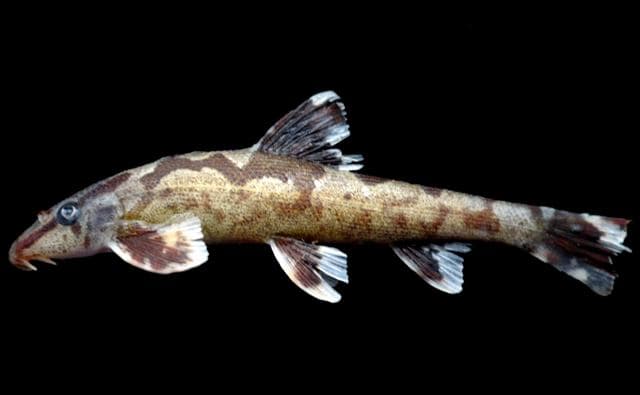
Hillstream Loaches have sucker type mouths and fins adapted to cling to rocks in fast moving waters!
Hillstream Loaches, also known as River Loaches, are a fascinating group of fairly small loaches. Most of these fish are only a few inches in length. They are generally found in rivers or streams, so to varying degrees, depending on the species, they are especially designed to cope with living in fast waters. As a group they are also sometimes called “Sucker Belly Loaches”, and there are some unique species found only from caves.
The Hillstream Loaches belong to the family Balitoridae, with about 485 species species described across about 58 different genera. They are all found throughout Eurasia with the exception of a single species that occurs in northeast Africa.
Although they are highly adaptable, Hillstream Loaches are best suited to a “river tank” type aquarium with a lot of water movement and a variety of stones and rocks. They also need a cooler aquarium and some can even adapt to a brackish environment. These fish tend to be shy and will often spend a good deal of time hiding under rocks or in the substrate.
There are a number of similarities found in both the Hillstream Loaches and the Loach family Cobitidae, such as multiple barbels around the mouth. Occasionally both the Hillstream Loaches and the Loaches are confused with the catfishes because of the presence of barbels. This lends to the confusion because of the number of barbels. All of these fish have between 3 to 6 pairs. Another is the appearance of being scaleless due to very tiny scales on some species. Yet all these fish are in fact covered with scales or partially covered with scales. Catfish on the other, are without scales, most often protected with bony plates instead.
The Hillstream Loach species list below includes popular varieties as well lesser known river loaches. Each fish guide has in-depth loach information including their places of origin, habitats and behaviors as well as the fish care needed for successfully keeping them in the aquarium. Fish pictures are also provided within each fish guide to help with identification, and to aid in choosing Hillstream Loaches as pets.
For Information on keeping freshwater fish, see:
Freshwater Aquarium Guide: Aquarium Setup and Care
Description
Most of the Hillstream Loaches are not very large, being only a few inches in length. They have developed quite a variety of body forms – round, cylindrical, compressed, some that are elongated, and a few that are flattened. They have a sucker type mouth and fins adapted to clinging to rocks in moving water. Some species are scaleless.
For the most part they are bottom dwellers found under rocks or in mud, and a few are found only in caves.
Care and feeding
These fish mainly get active in the evening or after dark. They are mostly bottom feeders and are omnivores. In their natural habitat many Hillstream Loaches primarily eat insect larvae, live worms, and crustaceans. They also nibble on algae and other vegetation. They can be fed sinking granules or tablets, dry flake food, frozen proteins such as tubifex, bloodworms, and brine shrimp, and vegetable substitutes such as a soft algae, algae wafers, and even a bit of Romaine lettuce or blanched kale leaves.
A “river tank” aquarium is best where there is a lot of water movement, a sand or gravel substrate, and a variety of stones and rocks for algae to grow on. They like hiding places where they can retreat to at will. They especially like to hide under rocks, plant roots or wood, and some species like to hide in caves.
Breeding
There is little known about the reproduction of most of these fish though there has been successful breeding with one species, the Eye-Spot Loach Acanthocobitis botia. There have also been some reported successes among hobbyists of various Hillstream Loaches mostly a matter of chance. Most of these fish are not yet commercially bred.
Homaloptera bilineata (Image Credit: S. Kulabtong, Wikimedia Commons CC BY-SA 3.0 Unported)



WFLo_Ap4A_vsm.jpg)







